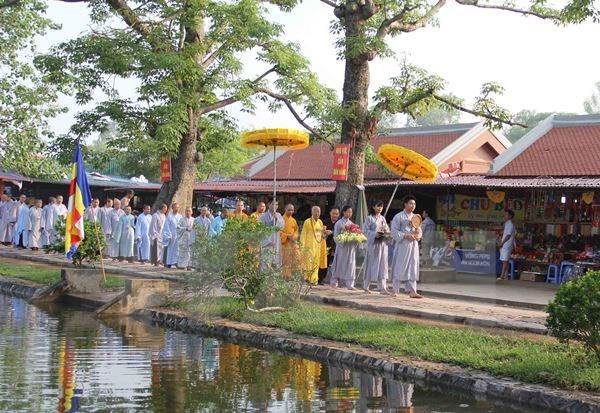
Vu Thu district in the northern province of Thai Binh held a ceremony on October 29 to begin Keo Pagoda festival and receive a certificate recognising it as national intangible cultural heritage.

Buddhist offerings - a ritual of Keo Pagoda festival
(Source: VNA)
The festival is held
annually from the 10th to 15th day of the ninth lunar month to honour Zen
Master Khong Lo (1016-1094) – founder of the Keo Pagoda.
It features religious rituals and communal activities such as Buddhist
offerings, palanquin parades, love duet singing on boats, and folk games.
Speaking at the event, Deputy Minister of Culture, Sports and Tourism Dang Thi
Bich Lien asked Thai Binh province to complete a project to preserve and
develop the festival.
The relic site management board and Vu Thu district authorities were asked to
ensure safety and order for the festival and promote its values to visitors.
Keo pagoda was founded in 1061. After it was swept away by a flood in 1611, the
pagoda was rebuilt in 1632 and most of its architectural features, including 17
structures with 128 rooms, remain until today. In 2012, it was recognised as a
national special relic site.
In addition to the autumn festival, another spring festival takes place here
annually on the 4th day of the first lunar month.
The pagoda attracts more than 2,500 visitors to Thai Binh every year.-
Source: VNA
The People’s Committee of Lac Son district held a ceremony on April 28 to receive the provincial relic certificate for the ancient rock carving site at Suoi Co stream, located in My Thanh commune.
A special music show titled "The country is in the fullness of joy” has been held at Hoa Binh Square in Hoa Binh city in celebration of the 50th anniversary of the liberation of the South and national reunification (April 30, 1975–2025).
The People's Committee of Lo Son commune, Tan Lac district, has organised the local annual traditional stream fishing festival on April 19 - 20.
As a land deeply intertwined with human history and Vietnam’s millennia-long journey of nation-building and defence, Hoa Binh is often revered for its epic tales and legends.
Residents of Hoa Binh boast a rich cultural identity, reflected in their unique language, traditional attire, customs, and folk melodies – described as "sweet as honey, clear as a mountain stream.”
Lac Son district’s Vu ban town held the 2025 Truong Kha temple festival on April 12–13 (the 15th–16th days of the third lunar month). Since its revival in 2019, the festival has been organised every three years, preserving valuable intangible heritage while meeting the community’s cultural and spiritual needs.



